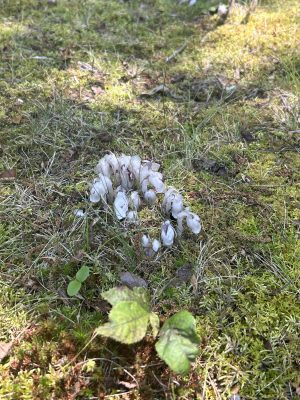By Dr. Matthew Lisy, UConn Adjunct Faculty

This Spathiphyllum wallisii is forty years old. In the fall of 2024, it wilted due to an extreme negative temperature change. (photo by M. Lisy)

This is the same Spathiphyllum wallisii showing a lot of new growth during the warm, humid summer of 2025. (photo by M. Lisy)
Plants, like humans, have an ideal temperature preference. In general, we like to have temperatures between 60 to 80 degrees Fahrenheit. Temperatures outside this range cause us stress. Our plants have very similar temperature requirements, only they have no ability to shiver or move! This past winter, I had a 40-year-old houseplant near my bedroom window. Our fall weather hit, and we dropped about 30 degrees in a day. My plant wilted and looked like it was going to die. After a long process of investigation and discussions with my fellow plant professionals, I can only conclude it was the rapid temperature change. The good news is that it made a full recovery once it adapted to the cooler weather.
This past winter, I had some Sansevieria that were under my windowsill. They get beautiful light in the later part of the day. The house is heated to 55 degrees, which is above their lower temperature tolerance, but the plants were not looking good. This spring, I found out that the storm window had fallen out of place. This set up a cold draft that negatively affected the plants, causing some formerly unexplained rot over the winter.
Not all plants have the same susceptibility to temperature. Cacti and succulents are usually from hot, arid climates. These plants are used to seeing temperatures soaring in the day, and then getting comparatively cold at night. As long as they are given proper light, most of these plants can tolerate life very easily in our homes. Even cold, unheated basements or outdoor greenhouses are just fine as long as temperatures stay above freezing.
Many of our plants come from the tropical forest floor where they are used to similar temperatures during the day and the night, all year long. While there is some adaptation to life in our homes, they have a preferred temperature and humidity range. There are some really neat “new” Philodendron species being offered for sale. Many of them have minimum temperatures of 60 or even 65. This can be difficult to do in an era where our smart thermostats are programed to turn down while we are not home, and up when we return in the evening. These temperature swings may be intolerable to our plants.
Be careful watering plants when the sun is shining. Those little water droplets can end up capturing the sun’s rays just like a greenhouse would. The droplets heat up and can actually burn a spot in the plant leaf. Remember, each drop can do this, so many times, the whole plant can look like a spotted mess!
Temperature can many times mark the difference between success and failure to keep some of the more difficult species of houseplants. Changes should be done slowly to avoid stress. If houseplants are kept outside in the summer, waiting too long can see the loss of some plants with lower temperature tolerances. Placing plants closer to the house or inside a simple greenhouse can help during the first cool nights of early fall. Especially sensitive plants should be brought in before any threat of cool weather. I learned this lesson the hard way with my prized Philodendron squamiferum. Its ideal temperature range is 65-85 degrees Fahrenheit. I had it in the basement and was planning on moving it to the first floor, but left it down there as the light was nice. While this plant technically can tolerate temperatures in the 50s for a short duration, it got too cold for too long and it dropped all its leaves one night (it died). As a general rule of thumb, if it is too cold for people, it will be too cold for our houseplants!
The UConn Home & Garden Education Center supports UConn Extension’s mission by providing answers you can trust with research-based information and resources. For gardening questions, contact us toll-free at (877) 486-6271, visit our website at homegarden.cahnr.uconn.edu, or reach out to your local UConn Extension center at cahnr.uconn.edu/extension/locations.
This article was published in the Hartford Courant August 2, 2025







